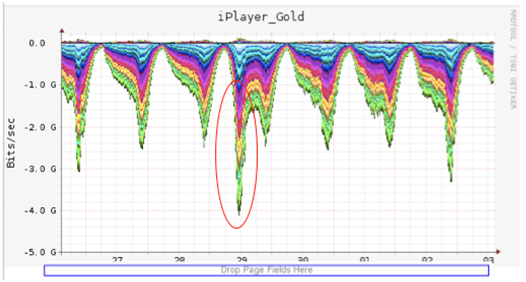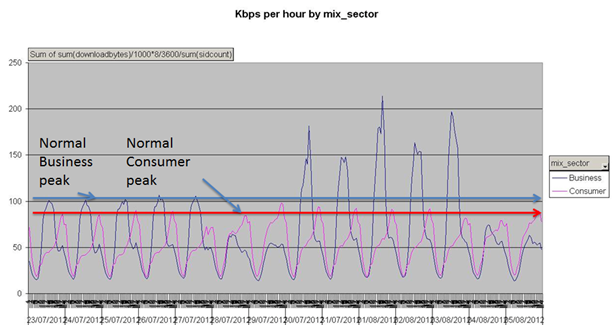Internet usage around big events
- Subscribe to RSS Feed
- Mark as New
- Mark as Read
- Bookmark
- Subscribe
- Printer Friendly Page
- Report to Moderator
- Plusnet Community
- :
- Plusnet Blogs
- :
- Internet usage around big events
Internet usage around big events
 Have you ever wondered how many other people are on the Internet doing the same thing as you? How many people are on the same page you are such as reading the same news article, or watching the same video as you? How about during a multinational event? Here at Plusnet, we thought we would find out just how significant big events are in terms of driving traffic. We live in a connected world, where anything that happens can be seen, photographed, reported on and read by billions of people. Here are some key statistics from the events that you may be familiar with over the past eighteen months.
Have you ever wondered how many other people are on the Internet doing the same thing as you? How many people are on the same page you are such as reading the same news article, or watching the same video as you? How about during a multinational event? Here at Plusnet, we thought we would find out just how significant big events are in terms of driving traffic. We live in a connected world, where anything that happens can be seen, photographed, reported on and read by billions of people. Here are some key statistics from the events that you may be familiar with over the past eighteen months.
- The London Olympics Opening Ceremony peaked at a whopping 10 gigabits per second of data being consumed
- Felix Baumgartner jumped from the stratosphere of Earth with a peak of 11 gigabits per second from Youtube traffic alone.
- April 2011 saw the Duke and Duchess of Cambridge tie the knot with 25% more traffic being experienced through iPlayer than on a normal evening.
Red Bull Stratos
Red Bull Stratos was a truly global event that saw millions of people tune in live to see daredevil Felix Baumgartner jump worldwide and many more view his achievements in the following days. If you haven’t heard of this, then here are some headline facts:
- It happened 128,100 feet above the earth – and was watched by millions.
- He reached 833.9mph in free-fall
- He landed 43.8 miles away from the launch site
To date 35 million people have watched Felix Baumgartner fall from space, with 8 million watching live. This is a massive number and we can see this representation in our graph below, which – unsurprisingly – shows a huge spike as more people came aware of the Austrian’s challenge and tuned into YouTube.  There is a steady incline as more households added to the downloading traffic until it reaches its peak (where the arrow points to), which is where Felix jumped from the balloon. If you were part of this, you were a small piece of YouTube history. After he had jumped and landed safely, there is a massive drop off as people turned off and did something else.
There is a steady incline as more households added to the downloading traffic until it reaches its peak (where the arrow points to), which is where Felix jumped from the balloon. If you were part of this, you were a small piece of YouTube history. After he had jumped and landed safely, there is a massive drop off as people turned off and did something else.
Royal Wedding
There is nothing more significant than a royal wedding to unite the world, with people from far and wide tuning in to see the then Prince William get married to Kate Middleton.
- Around 2 billion people worldwide watched the Royal Wedding.
- The current population of the world is just over 7 billion to give you some sense of scale.
- 2.8 million people in the UK and US posted a Facebook status about it in the 24 hours before the event
- Roughly 1,000 miles of bunting was sold to mark the occasion.
 Although not quite as massive on our network as Felix Baumgartner, many people opting instead to watch it live on the television, for those people out or perhaps having the misfortune of having to work on the occasion, it still managed to raise some healthy figures. At its peak, over 4 gigabits per second was being used for streaming from the BBC website. Much of the demand we saw at that time was from business customers, however, over 33% still came from consumers watching. The amount of bandwidth was triple the amount usually seen at this time of day too!
Although not quite as massive on our network as Felix Baumgartner, many people opting instead to watch it live on the television, for those people out or perhaps having the misfortune of having to work on the occasion, it still managed to raise some healthy figures. At its peak, over 4 gigabits per second was being used for streaming from the BBC website. Much of the demand we saw at that time was from business customers, however, over 33% still came from consumers watching. The amount of bandwidth was triple the amount usually seen at this time of day too!
London Olympics
The biggest and most sustained increase in Internet usage however has come from last year’s London Olympics. The organisers for the Olympics said they wanted to inspire a generation. So did they? Here are some statistics:
- 10,568 athletes competed
- 99 Olympic records were set
- Michael Phelps became the most decorated Olympian, winning his 22nd medal
The two-week, quadrennial sporting event saw Internet usage skyrocket – no more so than from business users. As we can see from the graph below, business use, depicted by the darker line, more than doubled across several days – no doubt as workers sneakily tuned into Olympics coverage whilst at their desks throughout the working week. Traffic from business use returned to a low level from the 3rd, which was incidentally the first weekend.  The most popular event of the Olympics, at least in bandwidth usage terms anyway, was when Bradley Wiggins took the Cycling Time Trial Gold medal, with a peak of 13Gbps. This was followed by the Tennis and 100m, with a peak of 12Gbps.
The most popular event of the Olympics, at least in bandwidth usage terms anyway, was when Bradley Wiggins took the Cycling Time Trial Gold medal, with a peak of 13Gbps. This was followed by the Tennis and 100m, with a peak of 12Gbps. 
So how does Plusnet cope with all this demand?
We know that people using our broadband, whether at work or at home, want to be able to watch big events particularly if it is once in a lifetime, such as the London Olympics was. In the case of events like the Olympics we have to consider not only the normal every day demand and the extra traffic from people watching the event but also increased usage from people working from home who didn’t want to travel. In order to ensure that everyday browsing, streaming and gaming continues to work as normal and everyone gets a good experience on the event traffic and their work VPNs Plusnet uses traffic prioritisation. This traffic prioritisation ensures that interactive and real time traffic will take priority over less time critical traffic, like file downloads, so that where one person in a household is watching the football game they don’t see any buffering because someone else is downloading the latest software updates for their phone at the same time. Were you part of our statistics through streaming any of these events? Do you prefer to watch events live on the Internet or in front of the television? Tell us your thoughts below…
